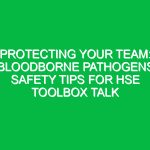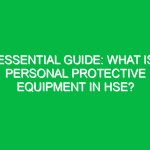Introduction
In the realm of health, safety, and environment (HSE), personal protective equipment (PPE) plays a pivotal role in safeguarding workers from potential hazards. But what exactly is PPE? Simply put, it refers to the gear designed to protect individuals from injuries or illnesses resulting from contact with physical, chemical, radiological, or mechanical hazards in the workplace. Its significance cannot be overstated; without effective PPE, employees may be exposed to risks that could lead to serious injuries or even fatalities. This article delves into the intricacies of PPE within the HSE context, exploring its components, regulations, and best practices, while providing insights into how organizations can enhance safety measures through proper PPE usage.
Understanding PPE in HSE
PPE encompasses a wide array of equipment, each tailored to address specific workplace risks. Common forms of PPE include:
- Helmets and hard hats
- Safety goggles
- Respirators
- Ear protection
- Gloves
- Protective clothing
- Fall protection systems
Each type of PPE serves a unique purpose. For instance, hard hats protect against head injuries from falling objects, while gloves shield hands from chemical exposure. Understanding the specific hazards associated with a workplace is crucial for determining the appropriate PPE required.
Key Components of Effective PPE
When it comes to implementing effective PPE in the workplace, several key components must be considered:
1. Hazard Assessment
Before selecting PPE, a thorough hazard assessment is essential. This process involves identifying potential risks in the workplace environment, whether they stem from chemicals, machinery, or environmental conditions. A case study in a manufacturing facility revealed that a detailed hazard assessment led to the identification of multiple risks, prompting the introduction of specialized PPE that significantly reduced workplace injuries.
2. Selection of Appropriate PPE
Once hazards are identified, the next step is selecting appropriate PPE based on the specific risks. Factors influencing this selection include the type of hazard, the duration of exposure, and the nature of the work being performed. For instance, workers handling hazardous materials may require chemical-resistant gloves, while those exposed to loud machinery might need hearing protection devices.
3. Proper Training
Even the best PPE is ineffective if workers do not know how to use it properly. Comprehensive training programs are vital to ensure that employees understand the correct usage, maintenance, and limitations of their PPE. A construction company that implemented regular training sessions noted a marked decrease in accidents, as workers became more aware of how to protect themselves effectively.
4. Maintenance and Inspection
Regular maintenance and inspection of PPE are critical to ensure its effectiveness. Damaged or worn-out equipment can compromise safety. Organizations should establish protocols for inspecting PPE before and after use, as well as guidelines for proper storage to prolong the lifespan of the equipment.
Benefits of PPE in the Workplace
The use of PPE offers numerous benefits that extend beyond mere compliance with regulations:
- Injury Prevention: PPE significantly reduces the risk of injuries and illnesses, creating a safer work environment.
- Increased Productivity: When workers feel safe, their focus shifts entirely to their tasks, enhancing overall productivity.
- Regulatory Compliance: Proper use of PPE ensures compliance with safety regulations, helping to avoid fines and legal repercussions.
- Employee Morale: Providing adequate safety measures boosts employee morale and fosters a culture of care and responsibility.
Identifying Hazards and Risks in the Workplace
Understanding potential hazards is integral to effective PPE implementation. Common hazards include:
Chemical Hazards
Exposure to harmful substances can lead to serious health issues. PPE, such as gloves, goggles, and respirators, can mitigate these risks effectively. For example, in a laboratory setting, the use of fume hoods and appropriate gloves is essential for handling toxic substances safely.
Physical Hazards
These include risks from machinery, tools, and working environments. Hard hats, safety shoes, and protective clothing are vital in construction sites where falling objects and heavy machinery pose significant risks.
Biological Hazards
Healthcare workers are often exposed to biological hazards such as viruses and bacteria. In such environments, PPE like masks, gloves, and gowns are crucial in preventing infections. The COVID-19 pandemic underscored the importance of PPE in healthcare settings, highlighting its role in protecting both workers and patients.
Regulations and Standards Governing PPE
Compliance with regulations and standards is non-negotiable when it comes to PPE. Various organizations, including the Occupational Safety and Health Administration (OSHA) in the United States, set forth guidelines that employers must follow.
OSHA Regulations
OSHA mandates that employers assess the workplace for hazards and provide appropriate PPE at no cost to employees. This regulation emphasizes the importance of ensuring that all workers have the necessary protective gear to perform their jobs safely.
ANSI Standards
The American National Standards Institute (ANSI) outlines the performance standards for various types of PPE, ensuring that equipment meets specific safety requirements. Employers must familiarize themselves with these standards to ensure compliance and provide effective protection.
Best Practices for Implementing PPE in the Workplace
To maximize the effectiveness of PPE, organizations should adopt the following best practices:
- Engage Employees: Involve employees in the PPE selection process to ensure that the equipment meets their needs and preferences.
- Regular Training: Offer ongoing training to keep employees informed about new hazards, equipment, and best practices.
- Feedback Mechanisms: Create channels for employees to provide feedback on PPE effectiveness and any difficulties they encounter.
- Stay Updated: Regularly review and update PPE policies to align with evolving regulations and new safety technologies.
Conclusion
In conclusion, personal protective equipment is a fundamental element of health, safety, and environmental practices. Understanding what PPE is and its significance within the HSE context is crucial for fostering a safe work environment. Through comprehensive hazard assessments, proper selection, effective training, and adherence to regulations, organizations can significantly mitigate risks associated with workplace hazards. The investment in quality PPE not only protects employees but also enhances overall productivity and morale. As we continue to navigate an increasingly complex work environment, prioritizing PPE will remain essential in promoting health, safety, and environmental sustainability. It’s a responsibility that benefits everyone—workers, employers, and the wider community.


